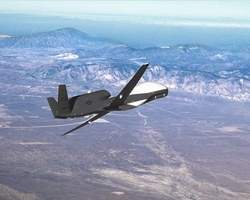Battle-Proven Technology Soon Available In Big Numbers
 Northrop Grumman
Corporation's Integrated Systems sector last week marked the
completion of the first production air vehicle of the US Air
Force's combat-proven RQ-4A Global Hawk unmanned aerial
reconnaissance system. In a ceremony at the company's Antelope
Valley Manufacturing Center in Palmdale, dignitaries rolled back a
curtain to reveal the air vehicle, called Global Hawk Air Force 1,
in its new operational gray-and-white paint scheme. The
vehicle will complete a final series of systems tests in
preparation for its first flight later this month.
Northrop Grumman
Corporation's Integrated Systems sector last week marked the
completion of the first production air vehicle of the US Air
Force's combat-proven RQ-4A Global Hawk unmanned aerial
reconnaissance system. In a ceremony at the company's Antelope
Valley Manufacturing Center in Palmdale, dignitaries rolled back a
curtain to reveal the air vehicle, called Global Hawk Air Force 1,
in its new operational gray-and-white paint scheme. The
vehicle will complete a final series of systems tests in
preparation for its first flight later this month.
Global Hawk is a high-altitude, long-endurance system that
provides near real-time intelligence, reconnaissance and
surveillance information to battlefield commanders day or night and
in all weather conditions. Northrop Grumman is the Air
Force's Global Hawk prime contractor.

"Northrop Grumman's employees, together with our entire
government/industry team, are extremely proud to provide this new
combat capability to the US warfighter," said Scott Seymour,
Northrop Grumman corporate vice president and Integrated Systems'
sector president. "Today's production weapon system has
already been proven in combat, which is a tribute to the US Air
Force's confidence in the system and the company's legacy of
excellence in designing and developing unmanned air vehicles.
Operating in Iraq, Global Hawk's sensors, communications and
mission control capabilities provided timely and persistent
awareness of the enemy's location, movements and intent. This
knowledge contributed significantly to the tempo of advance for
what was truly an integrated joint and coalition combat force."
Lessons learned from the Global Hawk deployment will be
instrumental in understanding how best to integrate unmanned
systems with air-land-sea and space forces to create a transformed
war fighting capability, added Seymour.
Only Eight Hawks In The World Today
 Global Hawk Air Force 1 is the
eighth Global Hawk air vehicle built. Northrop Grumman
produced the first seven under the advanced concept technology
demonstration (ACTD) phase of the program.
Global Hawk Air Force 1 is the
eighth Global Hawk air vehicle built. Northrop Grumman
produced the first seven under the advanced concept technology
demonstration (ACTD) phase of the program.
Following a final series of systems tests and a flight test
program at Edwards Air Force Base (CA), the vehicle will be
delivered to the Air Force's 9th Reconnaissance Wing at Beale AFB
near Sacramento (CA).
Although Global Hawk is still in engineering and manufacturing
development, and low-rate initial production, it has been
successfully deployed by the Air Force twice, first during
Operation Enduring Freedom in 2001, and again in 2003 during
Operation Iraqi Freedom.
Since its first flight in 1998, Global Hawk has logged more than
3,000 flight hours, more than half of them during operational
missions. "The entire program team has done an exceptional job in
transitioning the program from the ACTD environment to low-rate
initial production while supporting the needs of our nation's
defense forces," said Carl Johnson, Northrop Grumman vice president
and Global Hawk program manager.
Operating autonomously from takeoff to landing, Global Hawk
flies at altitudes up to 65,000 feet for more than 36 hours with a
range of 13,500 nautical miles.
 Using its synthetic aperture radar
and electro-optical and infrared sensors, the RQ-4A Global Hawk
provides high-quality reconnaissance imagery even in adverse
weather conditions, as demonstrated during sandstorms in
Iraq.
Using its synthetic aperture radar
and electro-optical and infrared sensors, the RQ-4A Global Hawk
provides high-quality reconnaissance imagery even in adverse
weather conditions, as demonstrated during sandstorms in
Iraq.
Its high altitude and long endurance allow it to
conduct surveillance over an area equal to the size of Illinois in
just 24 hours.
In addition to its use by the Air Force, Global Hawk has the
potential to complement US Navy operations. The Navy is
currently procuring two Global Hawk air vehicles for demonstrations
of the Global Hawk's maritime surveillance capabilities.
Northrop Grumman's Global Hawk program is based at Integrated
Systems' Unmanned Systems unit in San Diego, (CA) The company
performs final assembly at its Antelope Valley Manufacturing Center
in Palmdale.
 Aero-News: Quote of the Day (12.11.25)
Aero-News: Quote of the Day (12.11.25) ANN's Daily Aero-Term (12.11.25): Nonradar Arrival
ANN's Daily Aero-Term (12.11.25): Nonradar Arrival Classic Aero-TV: David Uhl and the Lofty Art of Aircraft Portraiture
Classic Aero-TV: David Uhl and the Lofty Art of Aircraft Portraiture Airborne-NextGen 12.09.25: Amazon Crash, China Rocket Accident, UAV Black Hawk
Airborne-NextGen 12.09.25: Amazon Crash, China Rocket Accident, UAV Black Hawk Airborne 12.05.25: Thunderbird Ejects, Lost Air india 737, Dynon Update
Airborne 12.05.25: Thunderbird Ejects, Lost Air india 737, Dynon Update






